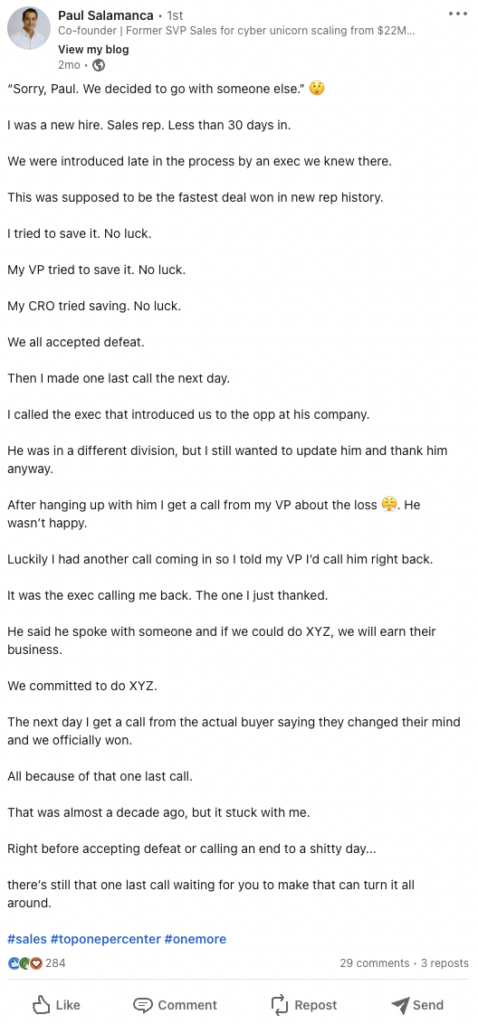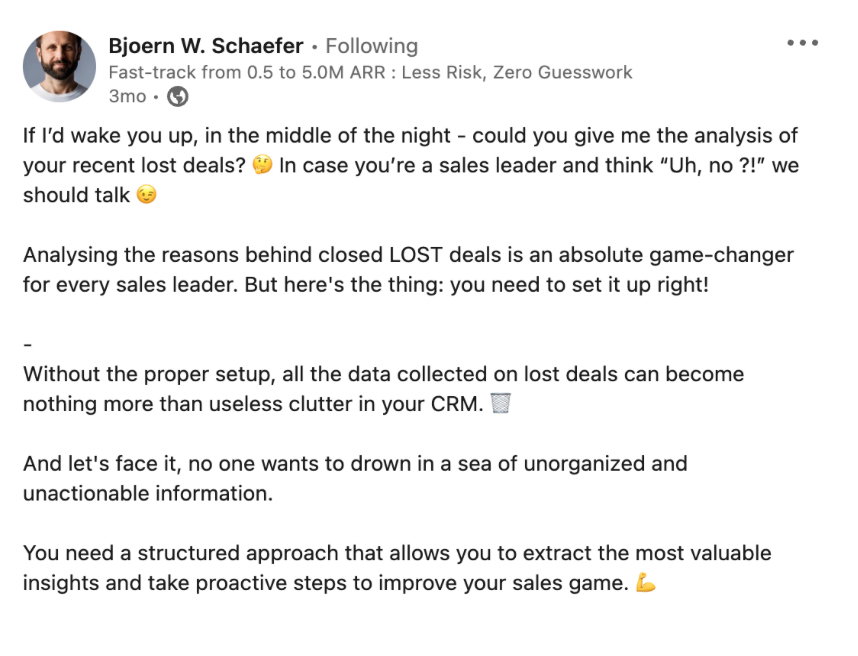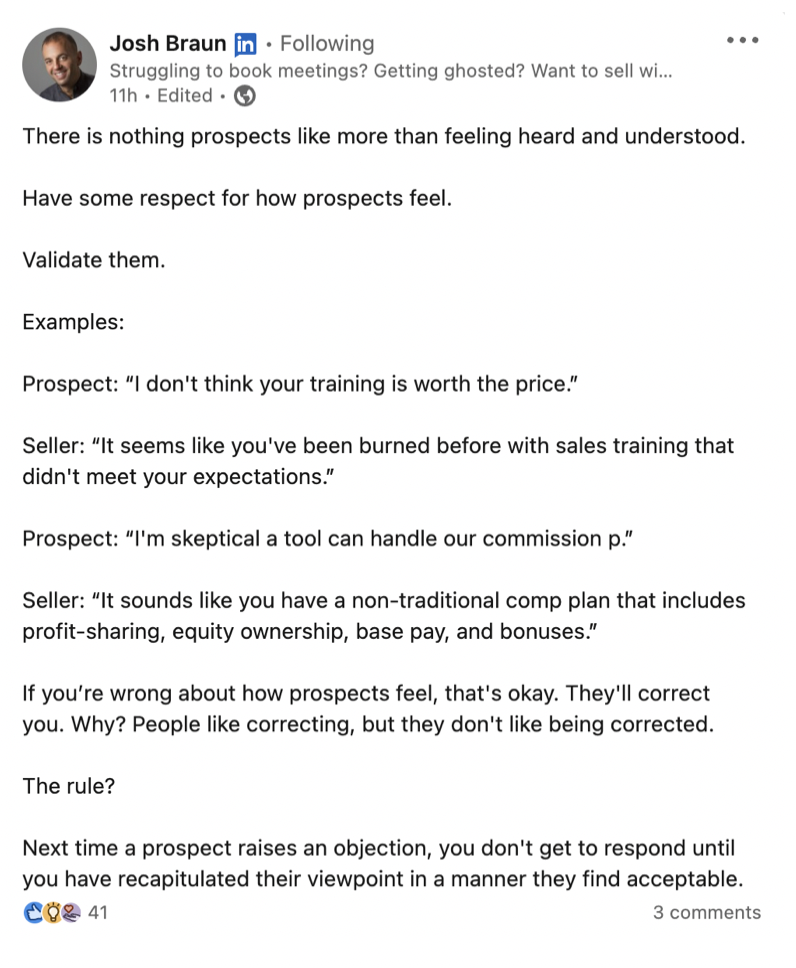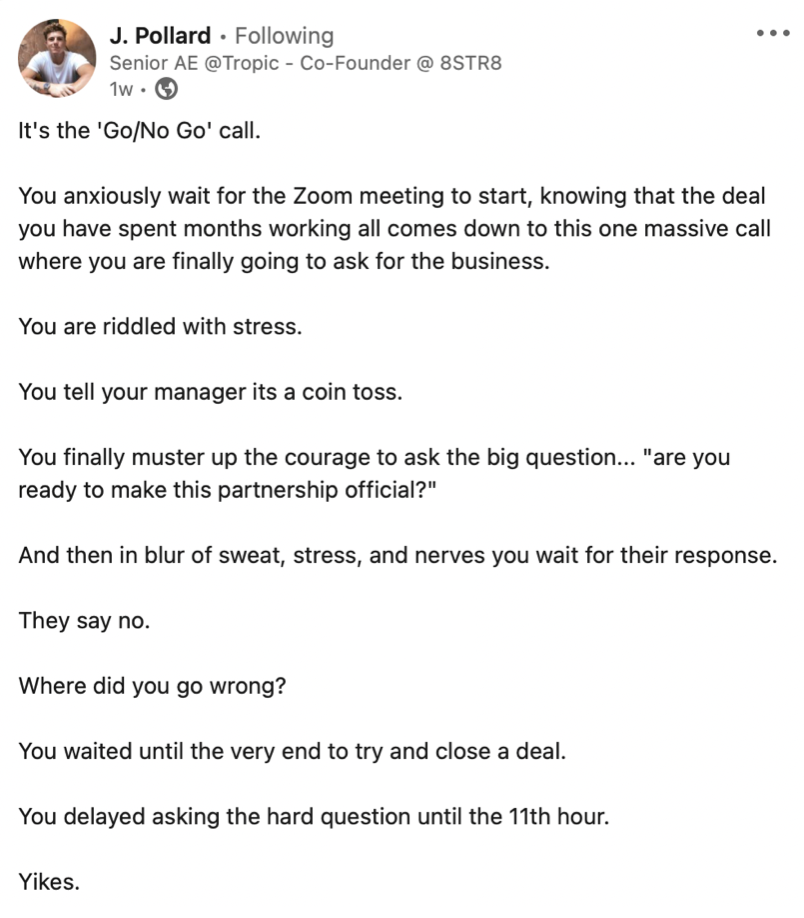“Sorry, we decided to go with someone else” – How a Single Call Can Save You a Lost Deal
“Sorry, we decided to go with someone else.” There isn’t a company in the world that likes to hear these words. There also isn’t a company in the world that hasn’t heard them before. We know because we hear them, too.
Some time ago, an amazing opportunity landed at our feet. And it was a big deal – pun intended. If we acquired them, the client would bring us tens of thousands of dollars per year.
We went back and forth in an effort to close that deal and within only a couple of days, we got all the way to discussing the contract.
Everything seemed to go so well.
But then those dreaded words came: “We are sorry, but…”
We lost.
But enough about us. Let’s discuss what you can do to save that groundbreaking deal and change your business.
Let’s start ⬇️
A “Fail to Win” Story From a Top 1% Salesman
According to Harvard Business Review, a 5% retention increase can boost your profit margin by up to 95%. Keeping customers on your side is clearly worth the effort.
When they do decide to leave, having your reps picking up the call and trying to win them back is definitely worth the effort. Actually, chances of winning back a customer are 2 to 4 times higher than landing a new one.
Take this story as an example. It’s actually so powerful that it inspired this entire blog.
Paul Salamanca, a TOP One Percenter Academy co-founder, shares how an idealistic newbie salesman turned a massive failure into a great win. With a single phone call!

As Paul says in the post, there’s always that last step your reps can take. It’s surprising, though, how few businesses actually encourage pursuing customers who weren’t initially interested. As much as 48% of them never even make a single follow-up attempt.
A report by Aberdeen Group claims that, on average, companies lose 12% of their yearly revenue due to poor sales practices like this one.
Now, translate it to numbers. If your business makes $10 million in annual revenue, you lose $1.2 million in sales each year.
Over 70% Of Firms Don’t Know Why Their Customers Churned
Adding to that, 46% of executives have no idea how many customers they lose each year.
Before your reps jump on a call to win back a lost deal, you may want to get a broader overview of why prospects are defecting and set up a proper communication strategy.
By analyzing your lost deals and learning from your mistakes, you can build tactics for building up your win-back sales strategy.

Believe us when we say that analyzing lost deals is worth your time. Recently, we created a detailed win/loss analysis of our deals from the last 6 months, which significantly impacted our sales process.
A cool example – One of our integrations was very similar to that of Aircall – our direct competitor. In fact, the integration provider was referring Aircall to their customers. After we identified this issue, we worked hard on strengthening our integration.
Now, we are one of the two providers the integration partner refers to.
But enough about our success. Let’s work on yours and take a look at our “quick win” and “slow burn” deal reactivation strategies (+ a bonus one).
Quick Win: C.U.R.E. The Lost Deal In 4 Simple Steps
When things go south with a deal, our brain automatically switches into defense mode – we try to “fix the mistake”. That’s not the best strategy. Around 84% of buyers decided on another company because the sales rep was too pushy.
Your reps must think tactically.
The C.U.R.E. tactic implements 4 strategic steps to nurture relationships and bring back that one customer who’s slipping away.

C: Calm The Prospect Down
In this step, the sales rep uses active listening and gives prospects a chance to open up. Whether your company didn’t live up to your promise or they just found “something better”, they always have something to tell you.
How can you reach the point where prospects start confiding in you? A simple “We are sorry” is a great first step. Admitting that something might have gone wrong from your side gives them the confidence to tell their story.
U: Understand Their Problem
According to the State of Business Communication 2023 report, 68% of business leaders claim that losing deals due to miscommunication has cost them over $10k. 13% estimate the number to be as much as $50k.
Make sure your sales reps always listen and understand prospects’ issues correctly. They should also be invested in more than selling your product. To be truly successful, they must show genuine interest in the prospect.
When a host of 20Sales podcast asked Doug Adamic, a CRO of Brex, what makes him such a great listener, he said:
“I am curious about how other businesses work and what my involvement can bring them. When I’m listening, I am actually focusing on whether they are experiencing something where I can help. To do that, you must be in the moment, be mindful. You have to get rid of all your preconceptions. When you do that, you connect with people on a different level. You find out that you are truly trying to help somebody to improve their lives. That’s the best part of it.”
Doug Adamic
Here are two key takeaways:
- Listen: Repeating what the prospect said to make sure everything is clear
- Understand: Asking a simple question → “Tell me more.”
We’d like to point out that the “Tell me more” phrase does more than ensure understanding. It encourages the prospect to share the real problem. It can even subconsciously trigger them to come up with their own solutions.

R: Remind Them of Their Initial Pain
Your prospects surely came to you with an issue or requirement, and you promised them to provide a solution.
First of all, reps should identify what happened with that initial pain point – did it change, or did your business fail to deliver on the promise?
Here’s a simple sentence your reps can use: “When we spoke the first time, you said that you need to /the main pain point/. Is that still accurate, or did something change?”
The prospect clarifies the situation, uncovers potential misunderstanding, and, most importantly, hints at a new angle on how reps can alleviate their pain. If nothing changes, they’ll be reminded of why they were interested in your product in the first place.
E: Explore your options
In the worst-case scenario, the prospects’ new requirements are so different from what you can offer that you simply can’t win them back.
But if there is a shift in their needs that you can deliver on, it works to your advantage. For example, the prospect might suddenly need a feature that you don’t have. But you may offer something similar under a different name that would also work for them.
If the rep and prospect agree on a new solution that works for both sides, now is the time to ask whether you have a deal.
Delaying the question can cost you that “yes” you are hoping for:

As the last step, your rep and the new customer have to set common objectives. They need to make sure there are clear next steps in place. The reactivated deal shouldn’t sit idle.
A Slow-burn Strategy: Achieve a 20% Sales Increase By Nurturing Your Prospects
All lost deals won’t be won in a single phone call. Despite the fact that recently lost deals are easier to close, on average, 37% of lost deals are still open in the pipeline after six months.
Some opportunities simply need nurturing – a slow-burn approach to building awareness and raising interest. According to a Demand Gen Report average, nurtured leads bring a 20% increase in sales compared to non-nurtured leads.
Here’s what the schedule for Closed-lost Opps Cadence should look like:

When implementing it, remember the following:
The First Phone Call Sets The Direction
Hearing nuance in prospects’ voices and elaborating on their answer in real-time is something you can only achieve through a phone call. It allows your reps to dive deeper and adjust their approach based on immediate responses.
It provides that extra layer of information.
The rep will also know whether the prospect is still worth saving.
What can the first call look like? Here’s a secret script for reactivating lost deals from Kyle Vamvouris, the CEO of the sales consulting platform Vouris.com:
A useful tip: Choosing a different SDR to handle the case may be a good strategy. It’s possible that the previous SDR and prospect simply didn’t click.
Different channels boost the chances of successful outreach
There is a very good reason to combine a cold call with email on the first day of the reactivation process. Email has a 2x higher return than cold calling, which supports the probability of reaching the prospect. To ensure that your emails are delivered successfully and avoid landing in the spam folder, it’s essential to craft authentic and personalized messages. One of the key steps in this process could be selecting appropriate cold email templates tailored to the specific audience you’re targeting. By using the right messaging approach, you can enhance the effectiveness of your outreach campaign and improve your chances of connecting with potential leads.
Multi-threading Increases Your Chances of Winning By 42%
Multi-threading is a sales strategy when reps build relationships with more than one person in the same company.
According to Aviso, this approach increases the odds of winning a deal by 42% compared to engaging only with one contact.
A current point of contact may still not be interested, but another decision-maker may be. Simply said, reps need to make some noise and get more people to evaluate your offer.
Within our Sales Insider series, we wrote an entire blog on multithreading. If you want to know if it helps us hold our win rates constantly above 35%, give it a read.
Sharing Product News May Regain Prospects’ Attention
A lot might have changed from when you started to communicate with the prospect. On day 15, reps can present them with recent product developments.
Chances are that by now, you launched a feature that they need, or that may be really significant for them. It’s true that a service upgrade as a reactivation strategy has the lowest success rate, but since it’s cheap, it has one of the highest ROI.
Hence, here’s a chance to show off and regain the prospect’s attention – ideally through a video call.
Prospects Need 30+ Days To Be Ready For Proposal
One month between outreaches may look like an extreme. But this is a necessary period where you give the prospect the time to evaluate. They need the time to breathe.
Once they had enough space, here comes day 66 – a final deal proposal.
A Controversial Strategy: Brutal Honesty Results In an 85% Retention Rate
There’s that deeply seeded belief among salespeople that in order to sell, reps have to stay positive at any cost. They must hide each mistake. They must keep pushing. They must do anything to win the deal.
What if we tell you the opposite works wonders, too?
Encourage reps to do something unexpected.
Encourage them to be brutally honest!
Prospects want to hear that they make sense. That their reasons are valid, and reps see that things just aren’t working out.
It may sound like you’re stabbing yourself in the back, but admitting their decision is justified will calm them down and/or open them up. We can prove it. Sprout Social study showed that 85% of consumers will stick with a transparent brand – even through a crisis.
We recommend reading a story of Tom Stimson, The number one Executive Coach and Advisor in the AV Industry, about how brutal honesty not only saved a deal for a company, but also made everyone happier.
And here’s one more tidbit from the wise man:

CloudTalk’s Success Story: We Won “Smartsail / Fair and Favour” Back With This Simple Persuasion Technique
At the beginning of this blog, we told you that we lost a deal. But we have many success stories, too.
This one may inspire you:
Our client, a financial company Smartsail and Fair and Favour, was facing a challenge while still with us.
More and more prospects started to block them. Why? Because they were using a single phone number for around 350 agents. A single unknown phone number calling the same person several times – that’s a receipt for getting blacklisted. Understandably, this led to a low success rate and a lot of frustration.
We offered them more phone numbers, but eventually, the bomb dropped: “We are switching to WhatsApp.”
“Why not?” They said. They were already using WhatsApp, it worked just fine, and it was cheaper.
Sounds like a done deal, right?
Well, not really, thanks to our stellar sales reps.
Gerrlane, our Senior Customer Success Manager, came up with a strategy. In situations like this, you have to run and grab any straw you can find. Fast. You must ask yourself – what can we offer them that they can’t refuse?
“I told them that I’m glad WhatsApp is working for them, but as a manager, think about this. How will you track your agents’ productivity? How will you deploy the level of security financial services require?”
Gerrlane, Senior CSM
They couldn’t answer.
That’s when we knew we succeeded. We created an urgency, turning their attention to something vital that the competitor simply couldn’t provide.
They came back a few days later.
And we lived happily ever after.
Winning Back Lost Customers Doubles Their LTV
To stress this again, don’t beat yourself up if your company just lost a big opportunity. On average, less than ⅓ of potential deals end up closed-won. It means that 70% of them don’t.
What you should regret is never trying to win that lost deal back. According to the Client Winback Benchmark Study, 26% of lost customers are reactivated thanks to a quality win-back campaign. Regaining lost customers also doubles their LTV.
So before you give up, remember.
There’s always one more step your reps can take.

















